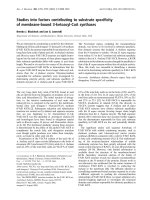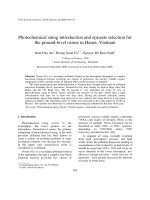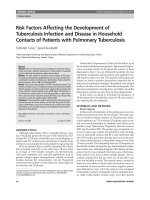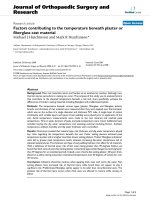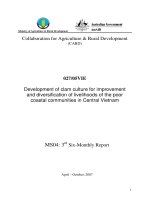Factors contributing to the development of the retail banking services in hanoi, vietnam
Bạn đang xem bản rút gọn của tài liệu. Xem và tải ngay bản đầy đủ của tài liệu tại đây (265.91 KB, 5 trang )
Asian Social Science; Vol. 11, No. 18; 2015
ISSN 1911-2017
E-ISSN 1911-2025
Published by Canadian Center of Science and Education
Factors Contributing to the Development of the Retail Banking
Services in Hanoi, Vietnam
Do Huu Hai1, Nham Phong Tuan2 & Pham Van Tuan3
1
Information Technology Institute (ITI) - Vietnam National University, Hanoi, Vietnam
2
Department of Strategic Management, Faculty of Business Administration, University of Economics and
Business, Vietnam National University, Hanoi, Vietnam
3
Faculty of Marketing, National Economics University, Vietnam
Correspondence: Nham Phong Tuan, Department of Strategic Management, Faculty of Business Administration,
University of Economics and Business, Vietnam National University, Hanoi, Vietnam. E-mail:
Received: March 19, 2015
doi:10.5539/ass.v11n18p364
Accepted: April 14, 2015
Online Published: June 5, 2015
URL: />
Abstract
This study focuses on factors contributing to the development of the retail banking services (RBS) in Hanoi,
Vietnam. A four factor model is established, corresponding to four hypotheses in this paper. Based on a sample
size of 615 customers and through a multiple regression analysis, results show that IT infrastructure - service
channels and tangibles are factors contributing to the development of the RBS in Hanoi, Vietnam. This result
suggests that customers care about the convenience, speed and quality of serving of banking staff. Therefore,
banks should always focus on upgrading IT infrastructure and online trading system; in addition, they often have
to improve facilities in workplace, professional services and marketing, etc. The paper provides several
implications to practitioners and suggestions for further studies.
Keywords: retail banking services, Vietnam, effects, IT infrastructure, Tangibles
1. Introduction
Development of retail banking operations is the tendency of the commercial banks in the world. In order to
survive and develop in a sustainable way, the banks are aimed at strengthening and developing the individual
customer groups, households and small and medium enterprises. This activity is sure to bring revenue,
restrictions and risk diversification.
Vietnam is considered as a potential market in the development of retail banking services because retail services
of commercial banks is still very weak, the competitiveness of products and services is not high and limited,
especially for the Commercial banking Joint Stock.
The commercial banks Vietnam has been developed retail banking service (RBS) as an inevitable trend,
consistent with the general trend of banks in the region and the world. This is a banking services for individual
clients and small businesses to ensure for effective risk management. Although the financial resources of local
banks has increased but It has remained at a low level and RBS hasn't met the demands of the economy, the
majority have been traditional services as capital raising services, credit, payment. The structure developed
between the services is irrational, modern distribution channels haven't been developed yet.
Researching to develop a system of solid arguments and evaluate the impact of these factors on the development
of RBS is really necessary. The objective of this paper is to study the factors affecting the development of retail
banking services of the commercial bank joint-stock in Vietnam.
2. Literature Review
All over the world, since 1980s, Parasuraman et al. (1985) identified five factors that generally affect the service
quality are the reliability, responsiveness, assurance, understanding the customer and tangibles. Besides, Elliot et
al. (1996) and Reeves and Bednar (1996) noted the impact of price on the use of banking services. Gerard and
Cunningham (2001) conducted their study to find out factors influencing the bank selection such as ATM, speed
of service. Holstius and Kaynak (1995) conducted his study to determine the most important factors influences
364
www.ccsenet.org/ass
Asian Social Science
Vol. 11, No. 18; 2015
the customers for choosing a bank and found that reception at the bank, fast and efficient services, lower service
charges, friendliness of personnel are most important criteria for selecting banks. Riggall (1980) showed in his
study that convenience of location is the most influential factor for bank selection by new comers. Laroche et al.
(1986) reveals that the most important factors in choice of bank were location, convenience, and spread of
service, competence and personnel behavior. In Vietnam, the studies of Le Kieu Anh (2012), Huynh Thi Tram
Anh (2011) and Nguyen Huynh Bao Chan (2010) shows factors affecting RBS include scale, the state of
macroeconomics, competition, information technology, legal environment, financial capacity, customers’
demand, distribution channels, and so on.
3. Research Methodology
Inheriting from the existing research, the authors have constructed four-factor model based on four hypotheses
(H1 => H4), modelling in Figure 1.
Hypothesis 1. Business scale of the commercial banks is positively and significantly related to development of RBS.
Hypothesis 2. Product and service price of the commercial banks is positively and significantly related to development of RBS.
Hypothesis 3. Tangible resource of the commercial banks is positively and significantly related to development of RBS.
Hypothesis 4. IT infrastructure of the commercial banks is positively and significantly related to development of RBS
Scale
H1
Price
H2
H3
Tangibles
RBS Development
H4
IT infrastructure – Service channels
Figure 1. Factors affecting the development of Retail Banking Services
In the four factors, each factor is involved in the different observed variables containing feedback from customer
about RBS, corresponding to each question in the delivered questionnaire (Table 1). The observed variables are
measured in Likert-type scales from 1 (strongly disagree) to 7 (strongly agree).
The authors delivered a questionnaire to 1.100 customers who have used the RBS in Hanoi at random, 615 of
which with valid answers were used for analyzing.
Table 1. Measurement of factors
Factors
Notations
Scale 1
Scale
Price
Tangibles
RBS
Development
IT infrastructure
Scale 2
Scale 3
Scale 4
Price 1
Price 2
Price 3
Price 4
Tangible 1
Tangible 2
Tangible 3
Tangible 4
Tangible 5
Tangible 6
Tangible 7
RBS Development 1
RBS Development 2
RBS Development 3
IT Infra 1
IT Infra 2
IT Infra 3
IT Infra 4
IT Infra 5
Contents
Banks provide diversity of service package involved in life aspects such as entertainment,
business and learrning.
Banks provide diversity of service package for many types users.
Banks constantly search and increase new services.
Banks apply well IT for specialized activities.
Banks provide the cheapest services.
Banks change the price under the certain circumstances.
Banks levy on the basis of the times of use.
Banks periodically levy.
Banks are equiped modernly.
Banks’ facilities are well.
Banks’ staff wear neaty and courtesy.
Brochures and documents about banks and their products are impressive.
Guidelines, forms and procedures of banks are always full listed.
Transaction locations are clean and comfortable.
Seats in waiting rooms of banks make customers satisfied.
Banks take responsibility for what they introduce and commit.
Banks efficiently perform their services.
Banks care about their customers.
Banks boost to apply the digital technology (Internet and Mobile) in transactions.
Banks provide many Automated Transaction Machines (ATM).
Customers prefer transacting at banking counters and branches.
Customers prefer transacting at ATM.
Customers prefer transacting on the Internet and Mobile.
365
www.ccsenet.org/ass
Asian Social Science
Vol. 11, No. 18; 2015
4. Data Analysis and Results
4.1 Exploratory Factor Analysis (EFA)
KMO and Bartlett's test is used to assess the appropriateness of exploratory factor analysis. Results show KMO
index (0.942) is high and has statistical significance at one percent (sig. 0.000). Therefore, the application of
exploratory factor analysis is consistent with the research data.
Eigenvalue representing the amount of variation of the determinants is used to extract the number of factors.
Factors with eigenvalues greater than one are retained in the model, so there are four factors for analysis. The
64.3% of total extracted variance shows 64.3% variation of variables.
EFA states Cronbach's Alpha tests of four factors in the researching model that are greater than 0.6, the observed
variables are greater than 0.5 and correlation of variables and sums are greater than 0.3 (Table 2). Cronbach's
alpha coefficient of the dependent variable – RBS development is 0.81; the load factors of the component
variables are greater than 0.5 and the variable-sum correlation coefficient is greater than 0.6. Therefore, the
scales of factors in the model is suitable to perform further analysis.
Table 2. Cronbach’s alpha test
Factors
Cronbach’s Alpha
Scale
0.903
Price
0.852
Tangible
0.897
IT Infrastructure
0.805
Observed variables
Scale 1
Scale 2
Scale 3
Scale 4
Price 1
Price 2
Price 3
Price 4
Tangible 1
Tangible 2
Tangible 3
Tangible 4
Tangible 5
Tangible 6
Tangible 7
IT Infra 1
IT Infra 2
IT Infra 3
IT Infra 4
IT Infra 5
Variable–sum correlation coefficient
0.815
0.792
0.827
0.710
0.576
0.730
0.725
0.750
0.630
0.659
0.706
0.671
0.757
0.794
0.708
0.616
0.508
0.560
0.618
0.652
Load factor coefficient
0.812
0.838
0.823
0.664
0.816
0.758
0.728
0.725
0.694
0.711
0.703
0.652
0.666
0.714
0.608
0.743
0.796
0.552
0.557
0.593
4.2 Confirmatory Factor Analysis (CFA)
CFA result presented the scale for factors in the researching model is consistent with the collected data. The
values of tests are Chi-square / df = 4.443; GFI = 0.895; TLI = 0.911 (> 0.9); CFI = 0.925 (> 0.9); RMSEA =
0.075 (<0.08). Therefore, the analysis result is reliable.
The standardized coefficients of the measurement are greater than 0.5 and the p-value of each concept pair is
0.05. On the other hand, the correlation coefficient together with standard deviation are not one and have
statistical significance. Therefore, the research model is adjusted to achieve convergence value and divergence
value. It does not happen the correlation between the error of approximation of the measurement in factors to
achieve unitary in the model.
After correction, pair of error of approximation e6 and e7 with MI estimated as 130.081 (highest value in all
pairs of error of approximation), so if the pair of error of approximation e6 and e7 are correlated, the covariance
between them will be 0.481 and Chi-square/df of the original model. Meanwhile, GFI and Chi-square/df will
also be improved and the research model will be more consistent with market data. Therefore, in case of e6 and
e7 connection and re-estimating the model, the result is mapped out as shown in Figure 2.
The estimation of the theoretical model was adjusted with 159 ranks which are freedom with Chi-squared 567
428 (p = 0.000). Other criteria are all reached as Chi-square/df = 3.569; GFI = 0.912; TLI = 0.934; CFI = 0.945,
366
www.ccsenet.org/ass
Asian Social Science
Vol. 11, No. 18; 2015
which are greater than the standard index 0.9 and RMSEA = 0.073 is less than the standard index 0.08. This
proves that the adjusted model is more consistent with research data than previous model.
Figure 2. Estimation of research model
Tests by using the Structural Equation Model (SEM) shows (Table 3) that two factors, including (i) IT
infrastructure - service channels and (ii) tangibles, have a strong influence on the RBS development; in which IT
infrastructure are more powerful than tangibles through the greater estimation coefficient 0.395 and 0.316
respectively. Meanwhile, there is no evidence on the effects of two other factors (price and scale).
Table 3. Results of SEM test
Relation
IT Infra => RBS
Price => RBS
Scale => RBS
Tangibles => RBS
Estimate
0.395
0.069
-0.012
0.316
S.E
0.066
0.067
0.051
0.084
C. R
6.029
1.029
-0.239
3.752
P
***
0.304
0.811
***
5. Conclusions
Through the research model and analysis of real data collected from the customers’ use of the retail banking
services of commercial banks in Hanoi and Ho Chi Minh City, the authors point out the factors affecting the
RBS development. They are IT infrastructure - service channels and tangibles.
This result suggests that customers care about the convenience, speed and quality of serving of banking staff.
Therefore, since further RBS development, banks should always focus on upgrading IT infrastructure and online
trading system; in addition, they often have to improve facilities in workplace, professional services and
marketing, etc.
However, the findings also describe that the scale and price of services seem not to impact the RBS growth. This
mean that the diversification of service types or price levels is very important, it is the supplement to above
implies that customers are willing to use high-price services or many different services under the conditions of
satisfying the expectations and corresponding to the amount they paid.
As a new research field, it is difficult to avoid certain restrictions. Firstly, extensive research object are most of
the banking services. Furthermore, although Hanoi is a national financial main banking center, the scope of the
study is still localized. In addition, the observations have not been split on the basis of the characteristics of the
367
www.ccsenet.org/ass
Asian Social Science
Vol. 11, No. 18; 2015
customers who answered questionnaire. Therefore, the authors recommend further studies can exploit this new
field in the more specific aspects, in order to accurately assess the factors affecting the RBS development.
References
Anderson, E. W., Fornell, C., & Lehmann, D. R. (1994). Customer satisfaction, market share and profitability:
findings from Sweden. Journal of Marketing, 58(3), 53-66. />Brandt, R. D. (1988). How service marketers can identify value-enhancing service elements. The Journal of
Services Marketing, 2(3), 35-41. />Busacca, B., & Padula, G. (2005). Understanding the relationship between attribute performance and overall
satisfaction: theory, measurement and implications. Marketing Intelligence and Planning, 23(6), 543-561.
/>Candida, D. (2005). The future of European retail banking. Reuters Business Insight. Retrieved May 20, 2009,
from />Carman, J. M. (1990). Consumer perceptions of Service Quality: an assessment of the SERVQUAL dimensions.
Journal of Retailing, 66(1), 33.
Caruana, A., Money, A. H., & Berthon, P. R. (2000). Service quality and satisfaction- the moderating role of
value. European Journal of Marketing, 34(11/12), 1338-1352. />Đào Lê Kiều Anh. (2012). Phát triển dịch vụ ngân hàng bán buôn và bán lẻ tại ngân hàng đầu tư và phát triển
Việt Nam. Trường Đại học Ngân hàng Thành phố Hồ Chí Minh.
Holstius, K., & Kaynak, E. (1995). Retail banking in Nordic countries: the case of Finland. International Journal
of Bank Marketing, 13(8), 10-20. />Huỳnh Thị Trâm Anh. (2011). Nâng cao chất lượng dịch vụ ngân hàng bán lẻ tại NHTMCP Eximbank Việt Nam.
Trường Đại học kinh tế TP Hồ Chí Minh.
Ngụy Thị Sao Chi. (2010). Đa dạng hóa các dịch vụ ngân hàng thương mại Thành phố Hồ Chí Minh trong điều
kiện Việt Nam gia nhập Tổ chức Thương Mại Thế Giới, Luận văn Thạc sỹ kinh tế. Trường Đại học Kinh tế
TP Hồ Chí Minh.
Nguyễn Huỳnh Bảo Châu. (2010), Phát triển dịch vụ ngân hàng Việt Nam trong giai đoạn 2006 -2010. Luận văn
Thạc sỹ kinh tế, Trường Học Viện Ngân hàng TP Hồ Chí Minh.
Riggall, J. (1980). A new study: how newcomers select banks. ABA Journal, July, 93-94.
Copyrights
Copyright for this article is retained by the author(s), with first publication rights granted to the journal.
This is an open-access article distributed under the terms and conditions of the Creative Commons Attribution
license ( />
368

